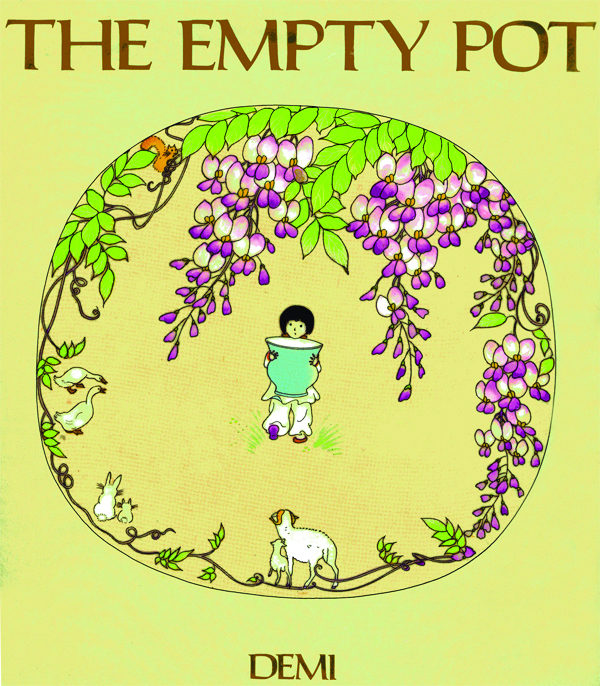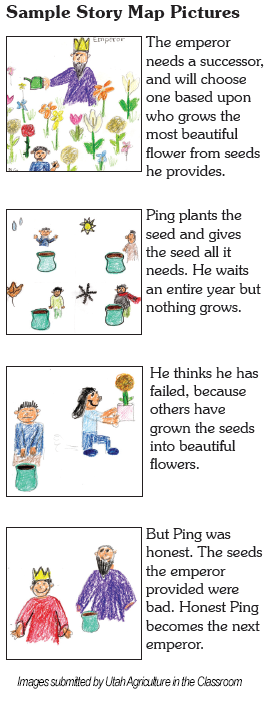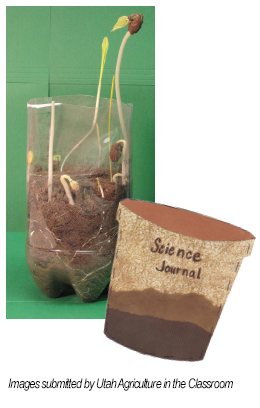Growing Plants in Science and Literature, More Than an Empty Pot (Grades 3-5)
Students use the story of The Empty Pot to explore literature and science, practicing story mapping and examining the needs of plants and the importance of soil and water. Like the characters in the story, students plant and observe the growth of seeds.
Background
Lesson Activities
Recommended Companion Resources
Credits
Author
Vanae Morris | Utah Agriculture in the Classroom
Standards
Texas Content Area Standards
-
ELA: 3.110.5.b.6
Comprehension skills: listening speaking, reading, writing and thinking using multiple texts. The student uses metacognitive skills to both develop and deepen comprehension of increasingly complex texts.
- ELA: 3.6.G: The student is expected to evaluate details read to determine key ideas.
- ELA: 3.6.H: The student is expected to synthesize information to create new understanding.
-
ELA: 3.110.5.b.7
Response skills: listening, speaking, reading, writing, and thinking using multiple texts. The student responds to an increasingly challenging variety of sources that are read, heard, or viewed.
- ELA: 3.7.D: The student is expected to retell and paraphrase texts in ways that maintain meaning and logical order.
- ELA: 3.7.E: The student is expected to interact with sources in meaningful ways such as notetaking, annotating, freewriting, or illustrating.
-
ELA: 3.110.5.b.8
Multiple genres: listening, speaking, reading, writing, and thinking using multiple texts- literary elements. The student recognizes and analyzed literary elements within and across increasingly complex traditional, contemporary, classical, and diverse literary texts.
- ELA: 3.8.C: The student is expected to analyze plot elements, including the sequence of events, the conflict, and the resolution.
-
ELA: 4.110.6.b.1
Developing and sustaining foundational language skills: listening, speaking, discussion, and thinking- oral language. The students develops oral language through listening, speaking, and discussion.
- ELA: 4.1.C: The student is expected to express an opinion supported by accurate information, employing eye contact, speaking rate, volume, enunciation and the conventions of language to communicate ideas effectively.
- ELA: 4.1.D: The student is expected to work collaboratively with other to develop a plan of shared responsibilities.
-
ELA: 4.110.6.b.6
Comprehension skills: listening, speaking, reading, writing and thinking using multiple texts. The student uses metacognitive skills to both develop and deepen comprehension of increasingly complex texts.
- ELA: 4.6.G: The student is expected to evaluate details read to determine key ideas.
- ELA: 4.6.H: The student is expected to synthesize information to create new understanding.
-
ELA: 4.110.6.b.7
Response skills: listening, speaking, reading, writing, and thinking using multiple texts. The student responds to an increasingly challenging variety of sources that are read, heard, or viewed.
- ELA: 4.7.D: The student is expected to retell, paraphrase, or summarize texts in ways that maintain meaning and logical order.
- ELA: 4.7.E: The student is expected to interact with sources in meaningful ways such as notetaking, annotating, freewriting, or illustrating.
-
ELA: 4.110.6.b.8
Multiple genres: listening, speaking, reading, writing, and thinking using multiple texts- literary elements. The student recognizes and analyzed literary elements within and across increasingly complex traditional, contemporary, classical, and diverse literary texts.
- ELA: 4.8.C: The student is expected to alaylze plot elements, including the rising action, climax, falling action, and resolution.
-
ELA: 5.110.7.b.1
Developing and sustaining foundational language skills: listening, speaking, discussion, and thinking- oral language. The students develops oral language through listening, speaking, and discussion.
- ELA: 5.1.D: The student is expected to work collaboratively with others to develop a plan of shared responsibilities.
-
ELA: 5.110.7.b.6
Comprehension skills: listening, speaking, reading, writing, and thinking using multiple texts. The student uses metacognitive skills to both develop and deepen comprehension of increasingly complex texts.
- ELA: 5.6.G: The student is expected to evaluate details read to determine key ideas.
- ELA: 5.6.H: The student is expected to synthesize information to create new understanding.
-
ELA: 5.110.7.b.7
Response skills: listening, speaking, reading, writing, and thinking using multiple texts. The student responds to an increasingly challenging variety of sources that are read, heard, or viewed.
- ELA: 5.7.D: The student is expected to retell, paraphrase, or summarize texts in ways that maintain meaning and logical order.
- ELA: 5.7.E: The student is expected to interact with sources in meaningful ways such as notetaking, annotating, freewriting, or illustrating.
-
ELA: 5.110.7.b.8
Multiple genres: listening, speaking, reading, writing, and thinking using multiple texts- literary elements. The student recognizes and analyzed literary elements within and across increasingly complex traditional, contemporary, classical, and diverse literary texts.
- ELA: 5.8.C: The student is expected to analyze plot elements, including rising action, climax, falling action, and resolution.
-
Social Studies: 3.113.14.c.4
Geography. The student understands the concepts of location, distance, and direction on maps and globes. The student is expected to:
- Social Studies: 3.113.14.c.14.D: interpret and create visuals, including graphs, charts, tables, timelines, illustrations, and maps
-
Science: 3.112.14.b.2
Scientific investigation and reasoning. The student uses scientific practices during laboratory and outdoor investigations.
- Science: 3.112.14.b.2.A: The student is expected to plan and implement descriptive investigations, including asking and answering questions, making inferences, and selecting and using equipment or technology needed, to solve a specific problem in the natural world.
- Science: 3.112.14.b.2.B: The student is expected to collect and record data by observing and measuring using the metric system and recognize differences between observed and measured data.
- Science: 3.112.14.b.2.D: The student is expected to analyze and interpret patterns in data to construct reasonable explanations based on evidence from investigations.
- Science: 3.112.14.b.2.E: The student is expected to demonstrate that repeated investigations may increase the reliability of results.
-
Science: 4.112.15.b.2
Scientific investigation and reasoning. The student uses scientific practices during laboratory and outdoor investigations.
- Science: 4.2.A: The student is expected to plan and implement descriptive investigations, including asking well defined questions, making inferences, and selecting and using appropriate equipment or technology to answer his/her questions.
- Science: 4.2.B: The student is expected to collect and record data by observing and measuring, using the metric system, and using descriptive words.
- Science: 4.2.D: The student is expected to analyze data and interpret patterns to construct reasonable explanations from data that can be observed and measured.
- Science: 4.2.F: The student is expected to communicate valid oral and written results supported by data.
-
Science: 4.112.15.b.9
Organisms and environments. The student knows and understands that living organisms within an ecosystem interact with one another and with their environment.
- Science: 4.9.A: The student is expected to investigate that most producers need sunlight, water, and carbon dioxide to make their own food, while consumers are dependent on other organisms for food.
-
Science: 5.112.16.b.2
Scientific investigation and reasoning. The student uses scientific practices during laboratory and outdoor investigations.
- Science: 5.2.A: The student is expected to describe, plan, and implement simple experimental investigations testing one variable.
- Science: 5.2.B: The student is expected to ask well defined questions, formulate testable hypotheses, and select and use appropriate equipment and technology.
- Science: 5.2.D: The student is expected to analyze and interpret information to construct reasonable explanations from direct (observable) and indirect (inferred) evidence.
- Science: 5.2.F: The student is expected to communicate valid conclusions in both written and verbal forms.
-
Social Studies: 3.113.14.c.15
Social studies skills. The student communicates in written, oral, and visual forms. The student is expected to:
- Social Studies: 3.113.14.c.15.D: express ideas orally based on knowledge and experiences
-
Social Studies: 4.113.15.c.21
Social studies skills. The student communicates in written, oral, and visual forms. The student is expected to:
- Social Studies: 4.113.15.c.21.C: express ideas orally based on research and experiences
- Social Studies: 4.113.15.c.21.D: create written and visual material such as journal entries, reports, graphic organizers, outlines, and bibliographies
-
Social Studies: 5.113.16.c.25
Social studies skills. The student communicates in written, oral, and visual forms. The student is expected to:
- Social Studies: 5.113.16.c.25.C: express ideas orally based on research and experiences
- Social Studies: 5.113.16.c.25.D: create written and visual material such as journal entries, reports, graphic organizers, outlines, and bibliographies
-
Science: 3.112.5.b.1
Scientific and engineering practices. The student asks questions, identifies problems, and plans and safely conducts classroom, laboratory, and field investigations to answer questions, explain phenomena, or design solutions using appropriate tools and models. The student is expected to:
- Science: 3.112.5.b.1.B: use scientific practices to plan and conduct descriptive investigations and use engineering practices to design solutions to problems
- Science: 3.112.5.b.1.E: collect observations and measurements as evidence
-
Science: 3.112.5.b.2
Scientific and engineering practices. The student analyzes and interprets data to derive meaning, identify features and patterns, and discover relationships or correlations to develop evidence-based arguments or evaluate designs. The student is expected to:
- Science: 3.112.5.b.2.B: analyze data by identifying any significant features, patterns, or sources of error
-
Science: 4.112.6.b.1
Scientific and engineering practices. The student asks questions, identifies problems, and plans and safely conducts classroom, laboratory, and field investigations to answer questions, explain phenomena, or design solutions using appropriate tools and models. The student is expected to:
- Science: 4.112.6.b.1.B: use scientific practices to plan and conduct descriptive investigations and use engineering practices to design solutions to problems
- Science: 4.112.6.b.1.E: collect observations and measurements as evidence
-
Science: 4.112.6.b.2
Scientific and engineering practices. The student analyzes and interprets data to derive meaning, identify features and patterns, and discover relationships or correlations to develop evidence-based arguments or evaluate designs. The student is expected to:
- Science: 4.112.6.b.2.B: analyze data by identifying any significant features, patterns, or sources of error
-
Science: 4.112.6.b.3
Scientific and engineering practices. The student develops evidence-based explanations and communicates findings, conclusions, and proposed solutions. The student is expected to:
- Science: 4.112.6.b.3.B: communicate explanations and solutions individually and collaboratively in a variety of settings and formats
-
Science: 4.112.6.b.12
Organisms and environments. The student describes patterns, cycles, systems, and relationships within environments. The student is expected to:
- Science: 4.112.6.b.12.A: investigate and explain how most producers can make their own food using sunlight, water, and carbon dioxide through the cycling of matter
-
Science: 5.112.7.b.1
Scientific and engineering practices. The student asks questions, identifies problems, and plans and safely conducts classroom, laboratory, and field investigations to answer questions, explain phenomena, or design solutions using appropriate tools and models. The student is expected to:
- Science: 5.112.7.b.1.B: use scientific practices to plan and conduct descriptive investigations and use engineering practices to design solutions to problems
- Science: 5.112.7.b.1.E: collect observations and measurements as evidence
-
Science: 5.112.7.b.2
Scientific and engineering practices. The student analyzes and interprets data to derive meaning, identify features and patterns, and discover relationships or correlations to develop evidence-based arguments or evaluate designs. The student is expected to:
- Science: 5.112.7.b.2.B: analyze data by identifying any significant features, patterns, or sources of error
-
Science: 5.112.7.b.3
Scientific and engineering practices. The student develops evidence-based explanations and communicates findings, conclusions, and proposed solutions. The student is expected to:
- Science: 5.112.7.b.3.B: communicate explanations and solutions individually and collaboratively in a variety of settings and formats
 Prior to starting the activities for this lesson, introduce the students to the story of The Empty Pot. Hold up the book and activate prior knowledge by asking the students to describe what they see on the cover. Discuss the artwork, the concept of a folktale, the depiction of the boy on the cover, and some general cultural aspects of China.
Prior to starting the activities for this lesson, introduce the students to the story of The Empty Pot. Hold up the book and activate prior knowledge by asking the students to describe what they see on the cover. Discuss the artwork, the concept of a folktale, the depiction of the boy on the cover, and some general cultural aspects of China. Discuss the setting, main characters, and problem presented in the story and chart the sequence of events. You may wish to use the
Discuss the setting, main characters, and problem presented in the story and chart the sequence of events. You may wish to use the  After the experiment is completed, review with the students the things needed for plant growth:
After the experiment is completed, review with the students the things needed for plant growth: